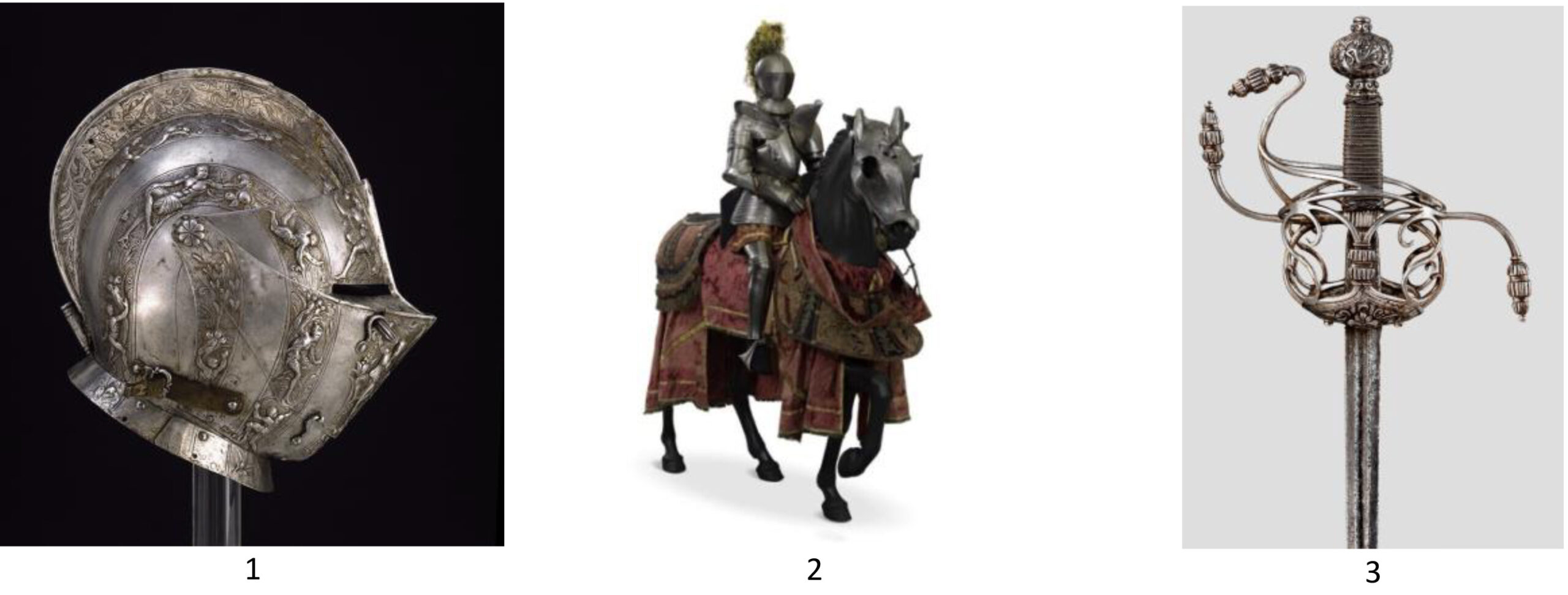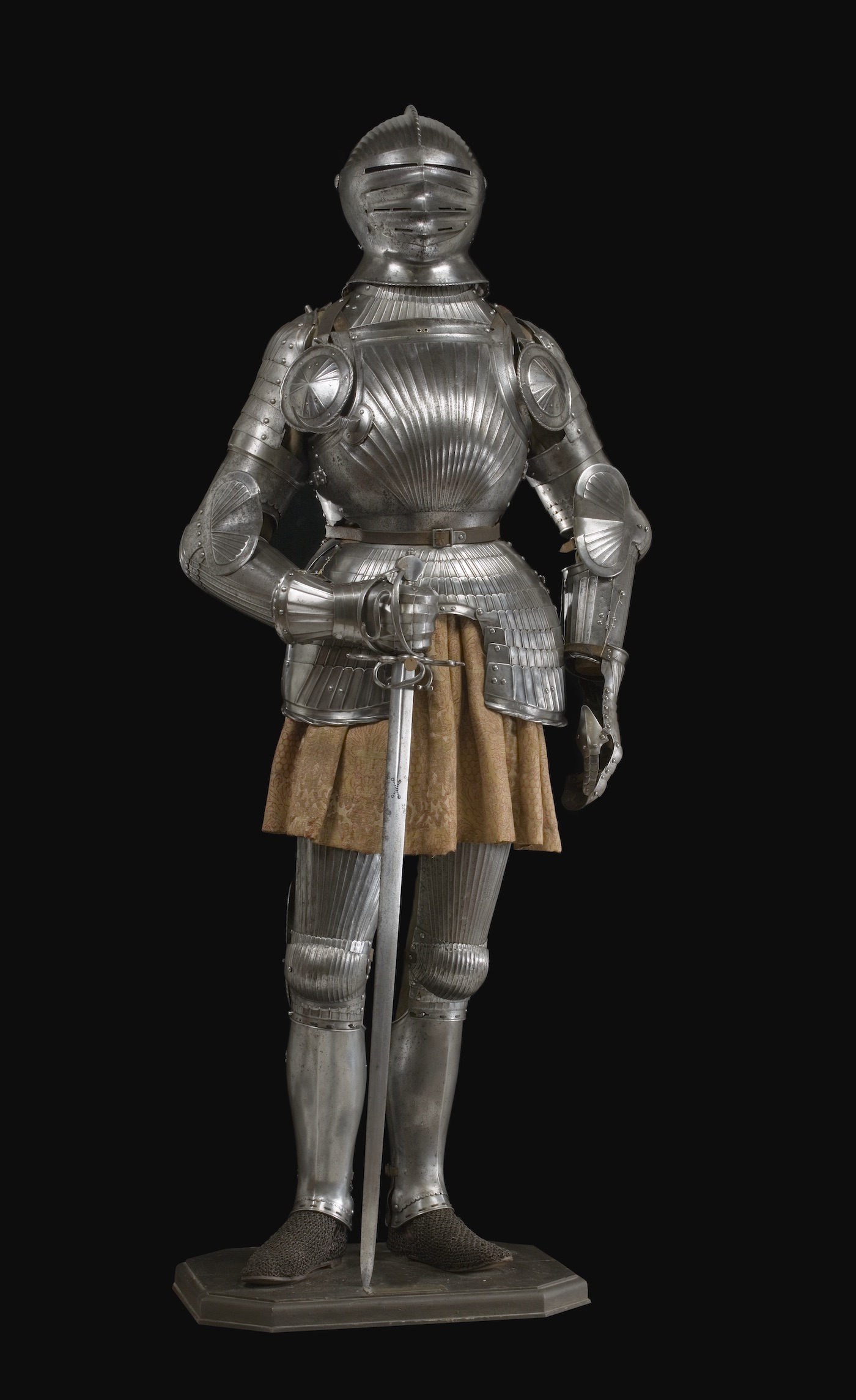Knights in Armor
July 1–October 10, 2022

NASHVILLE, Tenn. (May 18, 2022)—The Frist Art Museum presents Knights in Armor, an exhibition of remarkable Renaissance arms and armor from the world-renowned collection of the Museo Stibbert in Florence, Italy. Organized by Contemporanea Progetti in collaboration with the Museo Stibbert, the exhibition will be on view in the Frist’s Upper-Level Galleries from July 1 through October 10, 2022.
With more than one hundred engaging objects—including full suits of armor, mounted equestrian figures, helmets, swords, and paintings—Knights in Armor tells the fascinating tale of the European knight. While describing the historical and functional contexts of Renaissance arms and armor, the exhibition simultaneously highlights the undeniable beauty and artistic appeal of these works.
Knights were mounted soldiers who fought in battles, jousts, and tournaments, and required special cladding to cover their bodies from head to toe. “In the Middle Ages, knights wore mail, armor made of a mesh of interlocking rings. This exhibition, however, focuses on a later chapter in their history when, just before 1500, they transitioned almost completely to wearing plate armor, which provided superior protection,” says Frist Art Museum senior curator Trinita Kennedy. “Wearable sculpture and fashionable dress as well as defensive protection, plate armor was produced in sophisticated shapes and enhanced with etched and embossed ornament and inscriptions. Horses were elegantly outfitted with their own armor, known as a bard.”
Approaching the exhibition entrance, guests are greeted by an impressive German suit of armor from the early 16th century in the style favored during the reign of the Holy Roman Emperor Maximilian I. The introductory gallery explains how a boy became a knight and includes armor made for children to signal status and dynastic power. Emphasizing armor as fashion, this gallery also features a large full-length portrait of the sixteenth-century Italian knight Giovan Battista Del Monte dressed in elegant armor. “Knights sought to draw attention to themselves through splendid attire, and their armor was made to shine,” says Kennedy. “While ordinary foot soldiers typically wore mass-produced armor, knights had their armor custom made and personalized with coats of arms, monograms, mottos, or ornament significant to them. Decoration was concentrated around the head, chest, and hands—the most prominent parts of the body.”

The second gallery, which spotlights two grand equestrian figures, focuses on iconic armor. During the Renaissance, a knight’s full armor, known as a harness, was a complex assembly of about twelve to fourteen parts that together weighed approximately forty to forty-five pounds. Diagrams explain the function of each component, such as helmets, breastplates, couters, and greaves for men and chanfrons for horses. A range of armor from throughout Europe, including France, Germany, Italy, and the Netherlands, will be on view. The most significant centers of armor production were Milan in northern Italy and Augsburg in southern Germany. During the Renaissance, expert armorers such as Pompeo della Cesa and Desiderius Helmschmied helped elevate armor to an artform.
The third gallery is dedicated to jousts and tournaments—mock battles that allowed knights to display their skills before a judge and spectators. It features representations of these popular spectacles and the special helmets and other elements that knights added to their armor to protect themselves and enhance their appearance.
Weapons are the major focal point of the final gallery, with a strong emphasis on the wide variety of sword styles favored by knights, as well as other types of arms such as crossbows, maces, and polearms. Like armor, weapons were often ornamented with imagery and inscriptions. The proliferation and improvement of firearms during the Renaissance had significant consequences for armor, eventually leading to its decline and obsolescence. To be bulletproof, plate armor had to become thicker and thicker until it was too heavy to wear. “By the second half of the seventeenth century, full plate armor was no longer being worn by combat soldiers; during the eighteenth century, many of Europe’s great armories, such as the one assembled by the Medici family of Florence, were auctioned off and dispersed,” says Kennedy.
In the nineteenth century, a new interest in historical arms and armor emerged during the Gothic Revival, a movement characterized by an admiration for the art and culture of the Middle Ages and Renaissance. “With tremendous enthusiasm, the Anglo-Italian art collector Frederick Stibbert (1838–1906) began assembling his collection in 1859. Knights in Armor provides an extraordinary occasion to see in America many of the finest examples of European arms and armor from his one-of-a-kind museum, housed in a villa perched on a hillside above Florence,” says Kennedy. The exhibition concludes with examples of nineteenth-century armor that Stibbert commissioned to display and wear himself.
For guests coming to see this exhibition with families and school groups, the Frist Art Museum has developed a special companion tour that leads them along the path to knighthood through the perspective of a young fictional knight named Marco. In the Frist’s interactive Martin ArtQuest® Gallery, guests of all ages can look forward to new art-making activities, including designing shields, creating armor for model horses, drawing a knight, animating mythical creatures, building block castles, and much more.
Programs
Thursday, June 30
Curator’s Perspective: The Aesthetic of Knights in Armor
6:30–7:30 p.m.
Auditorium
Free
First come, first seated
Join organizing curator Riccardo Franci of the Museo Stibbert to learn about the exhibition Knights in Armor, in which some of the most aesthetically significant works from the museum’s collection of arms and armor are on display.
Saturdays, August 6, September 17, and October 1
Adult ARTlab: Metalworking Presented by The Forge Nashville
10:30 a.m.–4:00 p.m.
Frist Art Museum and The Forge Nashville (formerly Fort Houston), 217 Willow Street, Nashville
$50 members; $65 not-yet-members (all supplies, gallery admission, and parking validation included) Ages 18+ only. Space is limited. All skill levels are welcome.
Join the Frist Art Museum and The Forge Nashville for an exploration of metalworking inspired by Knights in Armor. The day will begin with a tour of the exhibition at the Frist Art Museum. Then, we will meet at The Forge Nashville to learn more about metalworking during an interactive demonstration led by makers Duncan Stephenson and JB Williford. After an overview of the history of metalworking and metalworking processes and a demonstration of forging a spear, participants can try their hand at hammering some red-hot metal. Participants should wear long sleeves and pants, natural-fiber clothing, and closed-toed shoes (preferably boots, no sneakers). No polyester or workout gear.
About The Forge Nashville: Founded in 2012, The Forge Nashville (formerly Fort Houston Artisan Support Project) is a 501(c)3 nonprofit organization located in a 23,000-square-foot facility in the Railyard District near the Cumberland River. The Forge Nashville offers maker space, shops, a gallery, artist studios, and office space geared specifically toward the artisans and creatives of Nashville. No matter your creative medium, you can find resources and a vibrant community at The Forge Nashville. They support artists by offering access to professional equipment and classes, affordable work space, scholarships, and public and private events.
Thursday, July 28
Film: Monty Python and the Holy Grail (1975)
6:30 p.m. (running time: 91 minutes)
Auditorium
Free
Rated PG; first come, first seated
Join us for a screening of Monty Python and the Holy Grail with a special introduction by Sarah Childress, presented in conjunction with the exhibition Knights in Armor. This beloved cult classic replays Arthurian mythology in hilarious absurdist mode. In tenth-century England, King Arthur travels the countryside to find knights who will join him at his Round Table in Camelot. When God sends them on a quest to find the Holy Grail, King Arthur decides the knights should separate and search for the Grail individually. They eventually reunite in hopes that Tim the Enchanter will set them on the right path. Will faith, Tim’s “pointed” guidance, and holy hand grenades be enough to ensure the success of their quest?
Thursday, August 25
Film: The Green Knight (2021)
6:30 p.m. (running time: 130 minutes)
Auditorium
Free
Rated R; first come, first seated
Join us for a screening of The Green Knight with a special introduction by Sarah Childress, presented in conjunction with the exhibition Knights in Armor.
An epic fantasy adventure, The Green Knight tells the story of Gawain, King Arthur’s feckless and headstrong nephew, who irresolutely embarks on a quest to meet the challenge of the eponymous Green Knight, a tree-like giant and tester of men. Gawain contends with magic, ghosts, thieves, and schemers in what becomes a deeper journey to define his character as he navigates the perilous path towards honor and knighthood. From visionary filmmaker David Lowery (A Ghost Story) comes a fresh and bold spin on a timeless Arthurian legend.
Saturday, September 10
Film: Man of La Mancha (1972)
2:00 p.m. (running time: 132 minutes)
Auditorium
Free
Rated PG; first come, first seated
Join us for a screening of Man of La Mancha with a special introduction by Sarah Childress, presented in conjunction with the exhibition Knights in Armor.
This film adaptation of the Tony Award–winning musical stars Peter O’Toole and Sophia Loren and is based on the life of sixteenth-century Spanish writer Miguel de Cervantes and his signature work, Don Quixote. In the volatile days of the Spanish Inquisition, Cervantes and his squire make a living as traveling players, but soon find themselves imprisoned after being accused of crimes against the church. Now, facing the wrath of their fellow inmates as well as the inquisitors, Cervantes must persuade the unruly bunch not to burn his prized manuscript by performing it for them.
Exhibition Credit
Organized by Contemporanea Progetti in collaboration with the Museo Stibbert, Florence, Italy
Image Credits
1. French. Close helmet, ca. 1590. Steel. Collection of Museo Stibbert, Florence, Italy
2. Mounted figure with equestrian bard: Italian (Brescia). Suit of armor, 1560–65. Steel, mail, bronze, leather, and fabric; European. Chanfron, mid-16th century. Steel and leather; European. Bit and bridle, 16th century. Steel and bronze; European. Stirrups, 16th century. Steel and leather; European. Elements of barding (peytral and crupper), 19th century. Fabrics. Collection of Museo Stibbert, Florence, Italy
3. Dutch (Flanders). Side sword, 1620–30. Steel, steel wire, and wood. Collection of Museo Stibbert, Florence, Italy
Supporter Acknowledgment
Supported in part by The Sandra Schatten Foundation and The Anne and Joe Russell Family
With additional funding from the Frist Art Museum’s Friends of Renaissance Art
Spanish translation sponsor: Center for Latin American, Caribbean, and Latinx Studies at Vanderbilt University
The Frist Art Museum is supported in part by The Frist Foundation, the Metro Nashville Arts Commission, the Tennessee Arts Commission, and the National Endowment for the Arts.
Connect with us @FristArtMuseum #TheFrist #FristKnights
FOR ADDITIONAL INFORMATION
Buddy Kite: 615.744.3351, bkite@FristArtMuseum.org
Ellen Jones Pryor: 615.243.1311, epryor@FristArtMuseum.org
